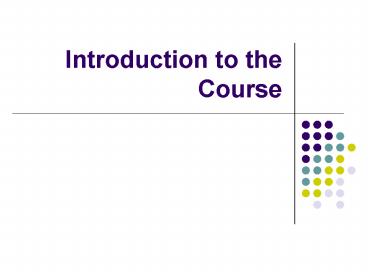Introduction to the Course PowerPoint PPT Presentation
1 / 36
Title: Introduction to the Course
1
Introduction to the Course
2
Course Content
- Introduction to the Course
- Biomechanical Concepts Related to Human Movement
- Anatomical Concepts Related to Human Movement
- Qualitative Analysis of Human Movement
3
Course Content
- Introduction to the Course
- Biomechanical Concepts Related to Human Movement
- Anatomical Concepts Principles Related to Human
Movement - Qualitative Analysis of Human Movement
4
Introduction to the Course
- The Discipline of Kinesiology
- Definition
- Purpose
- Use in Professions
- Organization of Kinesiology
- The Subdiscipline of Functional Anatomy
- The Subdiscipline of Biomechanics
5
Introduction to the Course
- The Discipline of Kinesiology
- Definition
- Purpose
- Use in Professions
- Organization of Kinesiology
- The Subdiscipline of Functional Anatomy
- The Subdiscipline of Biomechanics
6
Kinesiology Definition
- the discipline concerned with the comprehensive
and systematic study of human movement - What is the purpose of kinesiology?
7
Kinesiology Purpose
- To describe, explain, and predict how and why
people move for the purpose of
- Performance enhancement
- Injury prevention
- Risk reduction for chronic disease
- Social and aesthetic enjoyment
Technique Equipment Training
8
Kinesiology Purpose
- Performance enhancement ? the best performance
that one can achieve given the constraints (or
limitations) acting on the system
safety ? effectiveness ? efficiency
9
Introduction to the Course
- The Discipline of Kinesiology
- Definition
- Purpose
- Use in Professions
- Organization of Kinesiology
- The Subdiscipline of Functional Anatomy
- The Subdiscipline of Biomechanics
10
What is a profession?
- A body whose chief aim is to improve the
conditions of society by providing a regulated
service in which practices and educational/trainin
g programs are developed that are in accordance
with knowledge available from one or more
relevant disciplines
11
Kinesiology Professions
- Rehabilitation
- Physical therapists
- Occupational therapists
- Massage therapists
- Orthopaedists
- Cardiologists
- Cardiac Pulmonary Rehabilitation
- Athletic trainers
- Performance
- Strength Conditioning Coaches
- Athletic Coaches
- Musicians
- Actors
- Dancers
- Athletes
12
Kinesiology Professions
- Injury Prevention
- Physical education teachers
- Personal trainers
- Ergonomists
- Exercise specialists
- Massage therapists
- Athletic trainers
13
So
- Why do you have to take this course?
- How does this course fit into the study of
kinesiology?
14
Introduction to the Course
- The Discipline of Kinesiology
- Definition
- Purpose
- Use in Professions
- Organization of Kinesiology
- The Subdiscipline of Functional Anatomy
- The Subdiscipline of Biomechanics
15
Subdisciplines
16
Introduction to the Course
- The Discipline of Kinesiology
- Definition
- Purpose
- Use in Professions
- Organization of Kinesiology
- The Subdiscipline of Functional Anatomy
- The Subdiscipline of Biomechanics
17
The Subdiscipline of Functional Human Anatomy
- Subdiscipline of kinesiology concerned with
understanding - the contributions of the muscular and skeletal
systems to human movement - the acute and chronic effects of activity on the
musculoskeletal system - Focus is at the tissue, organ, organ system, and
organism level
18
- Also draws from biomechanics
19
Introduction to the Course
- The Discipline of Kinesiology
- Definition
- Purpose
- Use in Professions
- Organization of Kinesiology
- The Subdiscipline of Functional Anatomy
- The Subdiscipline of Biomechanics
20
Mechanics
- Branch of physics that is concerned with the
motion and deformation of particles and
mechanical systems that are acted on by
mechanical disturbances called forces
21
Biomechanics
- The science that examines forces acting upon and
within a biological structure and effects
produced by such forces - The science that applies the principles of
mechanics to the conception, design, development,
and analysis of equipment and systems in biology
22
(No Transcript)
23
Branches of Mechanics
24
Physical Quantities
- Base quantity defined in terms of a standard
- Derived quantity defined in terms of one or
more base quantities - Units for quantities determined by system used
- SI system (Systeme International MKS system)
- British system
- CGS system
25
SI Base Quantities Units
length (m) the length of path traveled by
light in a vaccuum during a time interval of
1/299,792,458 of a second
British system Length foot Time second Mass
slug
26
SI Derived Quantities Units
27
SI Prefixes Multipliers
28
The Greek Alphabet
29
So
- How does this course fit into the study of
kinesiology?
30
(No Transcript)
31
You will
- be able to answer, in part, the following
questions - What causes movement?
- How can a movement be changed to improve
performance and/or prevent injury? - learn the language of kinesiology and gain basic
knowledge about movement causes and outcomes. - develop observation, analytical, and evaluative
skills necessary for analyzing human movement.
32
Course Objectives
- Explain the roles that the subdisciplines of
functional anatomy and biomechanics play in the
study of human movement. - Demonstrate knowledge of how skeletal and
muscular architecture and function interact to
create forces and torques that contribute to
injury and human movement performance.
33
Course Objectives
- Demonstrate knowledge of how the human body and
the external environment interact to create the
forces and torques necessary that contribute to
human performance and musculoskeletal injury. - Identify structural and mechanical factors that
limit successful performance in human movement
activities.
34
Course Objectives
- Perform a systematic qualitative anatomical
analysis of human movement activities or skills
in sport, dance, exercise, rehabilitation, work,
and daily living.
35
- QUESTIONS?
36
Next Lecture Topic
- Lecture Topic 2
- Subtopic A Basic Kinematic Concepts

